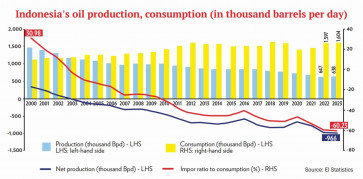Popular Reads
Top Results
Can't find what you're looking for?
View all search resultsPopular Reads
Top Results
Can't find what you're looking for?
View all search resultsEnergy self-sufficiency: Opportunities and challenges for the new government
Indonesia should boost oil exploration and production, enhance energy efficiency and diversify energy sources to achieve oil energy self-sufficiency.
Change text size
Gift Premium Articles
to Anyone
P
resident Prabowo Subianto has emphasized the importance of achieving energy self-sufficiency. He has reminded the country that dependence on foreign energy sources poses a serious threat amid global geopolitical tensions. Meanwhile, one of our most foreign-dependent energy sources is oil.
In 2023, Indonesia imported 43,800 tonnes of oil, equivalent to US$31.4 million (versus 33,800 tonnes of oil, equivalent to $18.8 million in 2019). The increase in Indonesia’s oil import value is influenced by relatively high global oil prices, increasing domestic oil demand and declining domestic oil production.
As of Nov. 8, the global average oil price (Brent) reached $80.90 per barrel. Although it has normalized from its peak average price in 2022 of $99.10 per barrel, this price is still quite high compared with the pre-pandemic average price in 2019 of $64.20 per barrel.
Going forward, global oil prices are expected to remain high due to several factors, oil remains the main energy source that is easily accessible and affordable, alternative technologies and energies have not fully replaced oil and the demand for petrochemical industries is expected to increase. In addition, the state budget would be burdened if global oil prices were higher than the targeted price in the state budget.
Meanwhile, domestic oil demand continues to rise. In 2023, domestic oil consumption reached 1.6 million barrels per day (versus 1.6 million barrels per day in 2022), an increase of 4.3 percent year-on-year (yoy). According to data from the International Energy Agency (IEA) in 2022, Indonesia’s oil consumption is mostly used in the transportation, household and industrial sectors, with shares of 72.3 percent, 14.2 percent, and 10.5 percent, respectively.
On the other hand, domestic oil production is still far below domestic oil consumption. Oil production in 2023 was only 638,000 barrels per day (versus 1.46 million barrels per day in 2000). This decline in oil production is influenced by several factors, oil reserves that continue to decrease due to long-term exploitation, many old wells whose production capacity decreases over time and lack of exploration related to costs, risk and investment.
Additionally, in the last four years, oil production has not reached the target. In 2023, oil production only reached 91.7 percent of the target (versus 91.6 percent of the target in 2022).


















